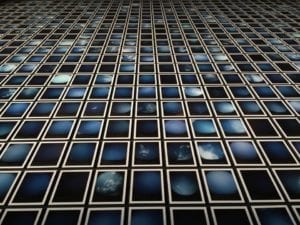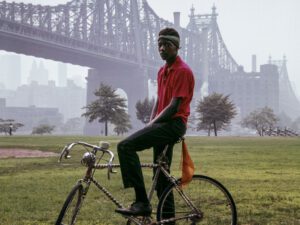For the 27th year running, The Deutsche Börse Photography Foundation Prize returns, emerging as one of the most important international awards for photographers, spotlighting outstanding and innovative work from across the globe. The 2024 finalist projects critically engage with urgent concerns, from the remnants of war and conflict, experiences of diasporic communities and decolonisation, to topics of equality, heritage, land and gender. The exhibition shows at The Photographers’ Gallery, London, until 2 June, before travelling to Eschborn / Frankfurt from 15 June – 15 September. This year’s shortlisted artists are Gauri Gill and Rajesh Vangad (b. 1970 and 1975), Lebohang Kganye (b. 1990) and Valie Export (b. 1940).

Gauri Gill and Rajesh Vangad present Fields of Sights, a photobook published by Edition Patrick Frey that reinvents the practice of painted photography. It’s a series that began in 2013, in Ganjad, Dahanu, a village in coastal Maharashtra, India. Gill’s photography initially captured the “chameleon-like skin” of the landscape. Soon after, however, the artist felt that something was missing in her pictures, and so she turned to Vangad. The artist inscribed his own mythical and experiential stories onto Gill’s photograph. The result imbuing the works with a multi-layered narrative that spoke to the realities of Warli life in the region, from floods and droughts to family and village life, unrest and terror, spirits and myths, as well as light and shadow. The result is a visual record that encapsulates multiple truths and systems of knowledge, encouraging viewers to explore the hidden, elusive layers that exist beneath the surface of images.


Elsewhere, we see the oeuvre of avant-garde Austrian artist Valie Export, known for her provocative public performances and cinema work. Export is shortlisted for her exhibition that ran at Fotomuseum Winterthur, Switzerland (2023), originating at the Albertina in Vienna. Through photographs, films and installations, the show deals with key issues including the body and the gaze, performance and the image, and subject and environment. She gestures towards and rallies against entrenched patriarchal structures through a fearless practice that upturns gender, sexuality and social norms on its head. Included is her famous Smart Expor (1970), an image that shows the artist defiantly holding a packet of cigarettes with her own face and logo mounted on. Also on display is Action Pants: Genital Panic (1969), part of a set of six identical posters that commemorate an action performed in Much in 1968. They show the artist sitting on a bench against a wall, wearing crotchless trousers and a leather shirt, holding a machine gun. She holds the gun at chest level, ready to turn it on a viewer at any moment. She explains, “When I was performing my actions in public, on the streets, in the urban space, new and different forms of reception developed. In the streets I provoked new explanations. I wanted to be provocative, to provoke, but also aggression was part of my intention. I wanted to provoke, because I sought to change the people’s way of seeing and thinking.”

South-African born Lebohang Kganye also appears for her exhibition Haufi nyana, as on display at Foam, Amsterdam in 2023. The artist uses experimental photography as a tool to navigate the multiplicity of identity, as well as recollections of the past. In vast installations, Kganye creates a space that resides between memory and fantasy. She collects stories from her family, with excerpts from South African literature, rewriting them into theatrical scripts. These appear as tableaux featuring cut-outs, shadows and silhouettes, fashioned from material in photo albums. In one composition, we see a subject with a wheelbarrow, another holding a child, whilst a third appearing as a pausing toddler. The exhibition’s title, translating to “too close” in Sesotho, reflects a dialogue between audience and artist, where, much like Gill and Vangad’s project, bridges the gap between heritage and identity, as well as physical and mental spaces.

Finally, Hrair Sarkissian is shortlisted for The Other Side of Silence, as shown at Bonnefanten Museum, Maastricht. Sarkissian’s conceptual photography focuses on deeply personal narratives. Born and raised in Syria, the grandson of Armenian genocide refugees, much of the artist’s work can be seen as an exploration of memory, grief and loss. His austere, large-scale photographs move between images, sculptures, soundscapes and installations. Ostensibly serene landscapes and deserted environments become sites of expressing trauma and difficult socio-political realities. The series moves through the public squares of Aleppo, Latakia and Damascus, the skies of Palmyra over modern Syria and the postindustrial landscapes of Armenia, revealing the muted wounds behind scenes of conflict.
“This year’s shortlist reflects the exhibitions programmed and photobooks published in Europe in the past 12 months.,” says Shoair Mavlian, Director of the Photographer’s Gallery. She continues, “It brings together a range of important themes showing the breadth of contemporary practice, such as feminist histories and performance, decolonial histories, contemporary conflict and displacement and indigenous rights.” The resulting exhibition interrogates and explores our world, highlighting four thought-provoking exhibitions. Each series speaks to each other, overall fostering a dialogue across creative and critical perspectives.
The Deutsche Börse Photography Foundation Prize 2024 | Until 2 June
thephotographersgallery.org.uk
Image Credits:
1. Hrair Sarkissian, In Between, 2006 © Hrair Sarkissian, Courtesy the artist
2. The Eye in the Sky, 2016, from the series Fields of Sight 2013-ongoing © Gauri Gill and Rajesh Vangad
3. VALIE EXPORT – SMART EXPORT Self-Portrait, 1970 © VALIE EXPORT, Bildrecht Wien, 2024, Photo: Gertraud Wolfschwenger
4. Aktionshose: Genitalpanik, 1969 (Action Pants: Genital Panic) from Aktion Performance © VALIE EXPORT, Bildrecht Wien, 2024, photo: Peter Hassmann
5. Mohlokomedi wa Tora, 2018, Scene 2 © Lebohang Kganye. Courtesy of the artist





